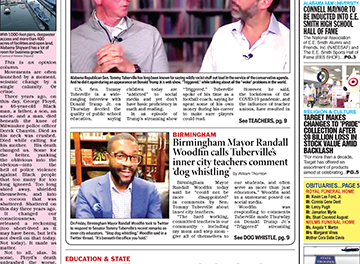This is an opinion column.
Something smells in north Alabama.
A group recently formed in Albertville to voice concern for the state of the city. Haitians were coming to town to work in a nearby chicken processing plant.
The “concern” was pretty transparent.
“If they are coming from Hati (sic) … THEY ARE GANG members and the ones they put out of the prisons,” a now-deleted post on the group “Concerned About Albertville” Facebook page said. “WHO KNOWS they are letting anyone come, could be the worst of the worst? They act like it.”
Some Albertville residents, up in arms, gathered at a public hearing on August 13 to air their grievances.
“The issue today is the mass migration coming here and what we’re gonna do about it,” one woman said. “We have to cut off the housing and that’s gonna be number one.”
Others agreed.
“We have got to stop the housing,” a man said. “If you stop the housing they won’t bring them here because there ain’t nowhere for them to live.”
“I’m gonna tell you something else. I’ve been to Haiti. … It’s got a smell to it. These people have smells to them. … These people are not like us. They don’t assimilate. They are not here to assimilate. They’re not here to be Americanized. They are not here to learn Alabama history and they don’t care about our schools.”
Group members rode around town, a self-appointed posse, searching for zoning violations by immigrants to report to the city. Because they ain’t like us.
A second public hearing, on August 26, was less caustic, as residents and some immigrants tried to ease tensions and put a less stinky face on the mess. No apologies, little self awareness. The group formed a nonprofit that would try to, well, Americanize immigrants.
It changed its name, too. To “Concerned About Alabama.”
Stick with Albertville, people. Please.
You can slather lipstick on that piggishness, but it’s a stain. And it’s not the only one. Albertville, and Marshall County, have chosen the banners they are proud to hoist. Just look in the cage outside the county courthouse there to see what’s important.
A cartoonish Civil War monument, etched into stone with neither artistic nor historical perspective and erected in 1996, 131 years after the war, is fenced off for its own protection. It stands between an Alabama flag left in tatters by neglect and a pristine Confederate Flag that serves not only as a middle finger to residents of color and those who believe in an inclusive Alabama, but a portrait of childish defiance.
“KEEP OUT,” the sign says. “Do not cross, climb, or leave articles on the barrier.”
The monument – I’m pretty sure even Confederate vets would be shocked by their amateurish depiction on this rock – is protected in part by Alabama’s monument preservations act. The flag is another story.

The history the battle flag represents is less about the Civil War than it is the rebellion against civil rights and Alabama’s rewriting of history. It was flown as a way to fight desegregation, to glorify the past and justify the actions of ancestors who went to war against their own country rather than to release people from slavery.
Alabama is so afraid of “divisive concepts” that it won’t let students study the sins associated with that flag. But counties can run ‘em up the flagpole and call that history.
Things change fast.
In 2020 news stories proclaimed that the Confederate battle flag in Albertville had been removed from its pole, replaced by the Sons of Confederate Veterans with a less recognizable and controversial flag – a replica of one used during Alabama’s secession convention.
But it was a bait and switch, said Unique Dunston, who has been fighting for the flag’s removal for years as founder of the group Reclaiming Our Time. The battle flag was down only briefly before it flew again.
“We protested for weeks and months and nothing ever happened,” she said.
Instead, the county passed a resolution limiting protest in front of the courthouse. And put a fence around it. And erected that warning sign.
“I think the message is how deeply rooted white supremacy is in Albertville specifically,” Dunston said. “As late as the early ‘90s, Albertville was still 98% white. So, it’s apparently really hard for the local white people to think any differently.”
The population in this town has changed, as immigrants came to work jobs at chicken plants that, frankly, many townspeople did not want. About 13% of city residents are now foreign born.
“We saw the same pushback when the Hispanic community started coming in,” Dunston said. “Now we’re seeing that resurface with the Haitian community.”
The reaction is disappointing. There had been signs of progress and acceptance.
In the wake of George Floyd’s killing in 2020, hundreds gathered in Albertville to acknowledge the injustice of his death, to show unity, Dunston said. But backlash quickly swallowed the progress, same as it did elsewhere.

Things change fast. And not at all.
I always wondered, looking back on Alabama’s troubled history, what could prompt white mobs to rail at children as they tried to register for school in places like Birmingham. I wondered what they thought when they saw pictures of themselves in the paper, the spittle flying from their mouths.
I think it serves as a reminder.
Haitian immigrants fleeing unrest and facing exploitation find ‘Alabama is the best place to live’Sep. 3, 2024, 6:00 a.m.
It has become popular now, in the name of being anti-woke, to embrace the words of xenophobia and symbols of white supremacy. Not just in places like Albertville but across the world.
It won’t always be so popular. So be careful of the words you choose. They might leave a stench.











